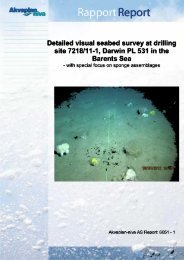A study of the priority substances of the Water Framework Directive ...
A study of the priority substances of the Water Framework Directive ...
A study of the priority substances of the Water Framework Directive ...
You also want an ePaper? Increase the reach of your titles
YUMPU automatically turns print PDFs into web optimized ePapers that Google loves.
22 Naphthalene<br />
� Naphthalene is a PAH. It is persistent and a<br />
human carcinogen.<br />
� Naphthalene is mostly monitored as part <strong>of</strong><br />
�PAH 16 in Norway.<br />
� Naphtalene is considered less toxic than o<strong>the</strong>r<br />
PAHs<br />
� For fur<strong>the</strong>r information, see PAH.<br />
Production and use<br />
Globally, <strong>the</strong> largest releases <strong>of</strong> naphthalene are<br />
results <strong>of</strong> <strong>the</strong> combustion <strong>of</strong> wood and fossil<br />
fuels and <strong>the</strong> production <strong>of</strong> coal tar.<br />
Naphthalene has been used in <strong>the</strong> manufacturing<br />
<strong>of</strong> azodyes, phthalic anhydride, naphthalensulphonic<br />
acid-formaldehyde condensation<br />
products, alkyl derivatives and solvent components.<br />
Naphthalene is also a component in some<br />
fumigants and repellents (moth balls).<br />
Emissions, discharges,<br />
distribution and hot-spots<br />
See PAH.<br />
Monitoring<br />
Naphthalene is monitored with �PAH 16 in<br />
Norway.<br />
Need for fur<strong>the</strong>r screening and monitoring<br />
See PAH.<br />
Analysis<br />
See PAH.<br />
References<br />
� CIRCA, Royal Haskoning: Fact sheets on<br />
production, use and release <strong>of</strong> <strong>priority</strong> <strong>substances</strong><br />
in <strong>the</strong> WFD, Naphthalene , Final version<br />
31 January 2001<br />
� HSDB: Naphthalene.<br />
� ClassLab: Naftalen<br />
FACTS<br />
Cas no.: 91-20-3<br />
Synonyms: Albo-carbon, Coal tar camphor,<br />
Naphthaline, Antimite, Naph<strong>the</strong>ne, Naphthalin,<br />
Naftalin, White Tar.<br />
Properties: White scales, balls, powder or cakes.<br />
Aromatic odour (mothballs).<br />
A <strong>study</strong> <strong>of</strong> <strong>the</strong> <strong>priority</strong> <strong>substances</strong> <strong>of</strong> <strong>the</strong> <strong>Water</strong> <strong>Framework</strong> <strong>Directive</strong><br />
TA-2140/2005<br />
naphthalene ::::::::::..<br />
Toxic effects: Fatal human dose (oral) is approx. 2 g<br />
(48 h) for a child, 5-10 g adult, LD50 (rat oral) is 2,6<br />
g/kg. Naphthalene is an irritant and a possible<br />
human carcinogen. It is very toxic to aquatic organisms<br />
(ClassLab) with LC50 for Pink salmon<br />
(Oncorhynchus gorbusch) at 1,4 mg/l (96 h).<br />
Log Kow: 3,01 - 3,7<br />
Persistence: No or little degradation under anaerobic<br />
conditions. Half-life in air and water is to 2,4-242<br />
weeks (biodegradation), while half-life in soil for<br />
naphthalene may be as low as 2-18 days (biodegradation),<br />
while half-life in air is expected to be 16<br />
hours (photolysis). Bioconcentration in aquatic<br />
organisms can be high.<br />
<strong>Water</strong> solubility: 30 mg/l at 20 °C<br />
Molecular formula: C10H8<br />
Metabolites: Via 1,2-epoxide into 1,2-dihydronaphthalene-1,2-diol,<br />
1,2-dihydro-1-naphthol and Nacetyl-s-(2-hydroxy-1,2-dihydronaphthyl)-cysteine.<br />
57:::..

















